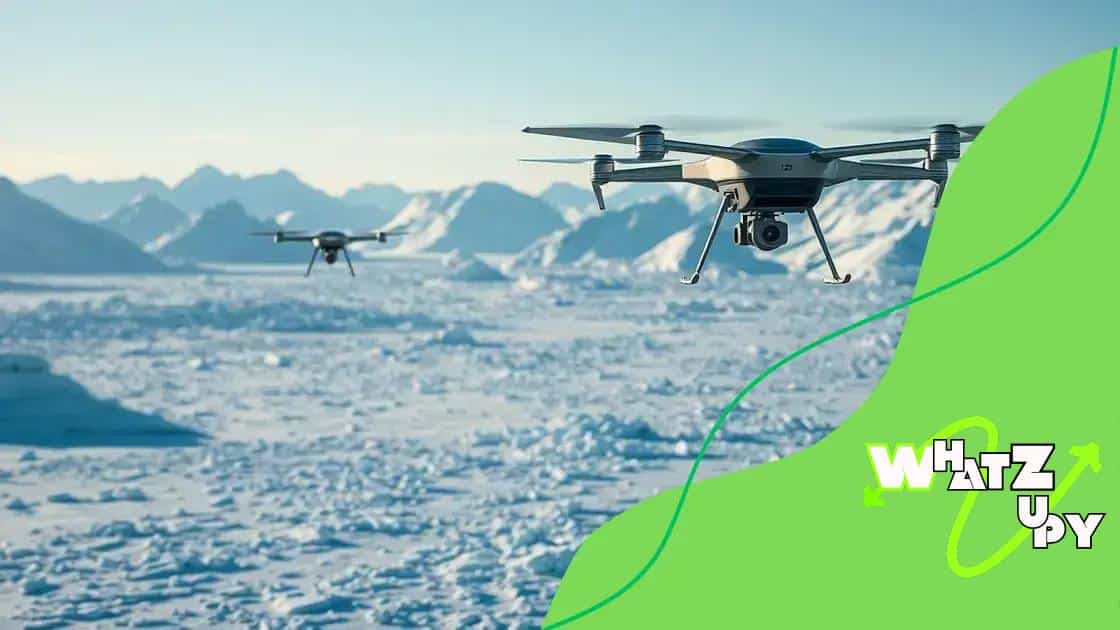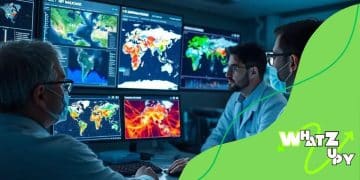Greenland surveillance directive 2025: what you need to know

The Greenland surveillance directive 2025 enhances environmental monitoring through advanced technologies while prioritizing sustainability and addressing privacy concerns for local communities.
Greenland surveillance directive 2025 is poised to change how we think about monitoring environmental impacts. What does this mean for sustainability efforts and the use of technology? Dive in as we explore its significance.
Understanding the Greenland surveillance directive 2025
The Greenland surveillance directive 2025 is an important policy aimed at enhancing environmental protection and ensuring sustainable development. This directive introduces advanced monitoring techniques to keep track of changes in the ecosystem. It’s crucial for stakeholders to understand the implications of this directive, as it affects not only conservation efforts but also local governance.
Key Goals of the Directive
This directive seeks to achieve several key objectives:
- Improve data collection on environmental impacts.
- Enhance cooperation between agencies.
- Promote transparency in surveillance practices.
By focusing on these goals, the directive can facilitate better decision-making processes that benefit both nature and the residents of Greenland. Furthermore, it fosters a collaborative approach that allows different sectors to participate in monitoring initiatives.
Technological Integration
The integration of technology is a cornerstone of the Greenland surveillance directive 2025. By utilizing satellite imagery and drone technology, real-time data becomes more accessible. This technological advancement enables more accurate assessments and timely responses to environmental threats, such as climate change and pollution.
For instance, the use of drones allows for detailed aerial surveys that can cover vast areas, ensuring no significant changes go unnoticed. Such initiatives enhance the ability to track wildlife populations and habitat alterations, which is vital in conservation efforts.
Community Engagement
Effective implementation of the directive also relies heavily on community involvement. Local populations are encouraged to participate through educational programs and volunteer opportunities. Engaging the community raises awareness about environmental issues and fosters a sense of ownership over local conservation efforts.
As communities become active participants, their insights and knowledge contribute significantly to the success of monitoring initiatives. This collaborative spirit ensures that the directive is not just top-down but includes valuable grassroots input.
Key implications for environmental monitoring
Understanding the key implications for environmental monitoring within the Greenland surveillance directive 2025 is vital for ensuring effective and sustainable practices. This directive establishes a comprehensive framework aimed at improving monitoring efforts across various environmental aspects.
Enhanced Data Collection
One major implication is the emphasis on enhanced data collection techniques. The directive promotes the use of innovative technologies that can provide more precise and timely data regarding environmental changes. This shift is important because accurate data lays the groundwork for informed decision-making.
- The use of satellite imagery helps in identifying land cover changes.
- Real-time data collection through sensors allows for immediate responses to environmental issues.
- Community monitoring programs enable localized data gathering.
With these advancements, stakeholders can address problems more swiftly and effectively, which is essential in times of climate change.
Collaboration Among Stakeholders
This directive also encourages collaboration among various stakeholders, including governmental bodies, local communities, and environmental organizations. By working together, these groups can share valuable insights and resources, leading to a more comprehensive understanding of environmental issues.
Such collaboration fosters a sense of communal responsibility, where local populations play active roles in monitoring and protecting their environments. This approach not only enhances environmental outcomes but also builds trust in governance.
Long-term Sustainability Goals
The implications extend to long-term sustainability goals as well. The Greenland surveillance directive 2025 aims to align environmental monitoring with broader sustainability objectives, ensuring that practices are not just reactive but also proactive.
This alignment helps create strategies that minimize negative impacts on ecosystems while promoting conservation. By prioritizing both monitoring and sustainability, the directive supports the creation of resilient natural environments.
How privacy concerns fit into the directive

Addressing how privacy concerns fit into the directive is crucial in understanding the Greenland surveillance directive 2025. This directive aims to enhance environmental monitoring while considering the potential implications for individual privacy.
Balancing Surveillance and Privacy
A key challenge is balancing effective surveillance with respecting citizens’ rights. The directive includes measures designed to protect personal data while still allowing for comprehensive environmental oversight.
- Data collection protocols are established to minimize invasive techniques.
- Public transparency about what data is collected fosters trust.
- Mechanisms for individuals to give or revoke consent for data collection.
By focusing on these protocols, the directive ensures that environmental goals do not come at the expense of personal privacy.
Community Involvement in Decision-Making
Community involvement is essential in shaping how privacy is addressed. Engaging local populations in discussions about surveillance tools allows for a better understanding of their concerns. When communities feel that their input matters, they are more likely to support environmental monitoring efforts.
Education on privacy rights and surveillance impacts enhances community awareness. This knowledge empowers citizens to participate actively, ensuring that monitoring practices align with community values and needs.
Legal Frameworks and Oversight
The Greenland surveillance directive 2025 also depends on legal frameworks that establish boundaries for data use. These frameworks are designed to prevent misuse of collected information and ensure that any surveillance is conducted within legal limits.
Additionally, oversight bodies are set up to examine practices regularly, ensuring that privacy remains a priority. This system of checks and balances helps ease concerns related to surveillance, making it more acceptable to those who might initially resist.
Technological advancements supporting the directive
The technological advancements supporting the directive are essential for achieving the goals set by the Greenland surveillance directive 2025. Cutting-edge technology plays a crucial role in enhancing environmental monitoring and data collection.
Remote Sensing Technologies
One of the most significant advancements is the use of remote sensing technologies. These tools allow scientists to gather data from large areas without needing to be present physically. This method is vital for monitoring changes in land use, ice melt, and vegetation cover.
- Satellites provide high-resolution imagery that helps track environmental changes over time.
- Drones facilitate detailed surveys in hard-to-reach regions, ensuring comprehensive data capture.
- Sensor networks deployed across different ecosystems continuously monitor conditions, providing real-time alerts.
These technologies ensure accurate and proactive responses to environmental issues while minimizing the need for intrusive fieldwork.
Data Analytics and Machine Learning
Another important element is the integration of data analytics and machine learning. Advanced algorithms can analyze vast amounts of data collected through various methods, identifying trends and patterns that would be difficult for humans to discern. This technology supports:
- Predictive modeling, which helps anticipate future environmental changes.
- Identifying potential threats to ecosystems early on.
- Optimizing resource management by analyzing historical data.
The ability to make data-driven decisions significantly enhances the effectiveness of the surveillance directive.
Public Engagement Platforms
Technological advancements also extend to public engagement platforms. Utilizing mobile applications and online tools empowers communities to participate in monitoring efforts actively. These platforms allow individuals to report environmental concerns and share data with authorities.
By involving citizens, the directive benefits from local knowledge and fosters a sense of shared responsibility. This engagement is crucial for building support and implementing successful environmental strategies.
Future perspectives on surveillance and sustainability
The future perspectives on surveillance and sustainability are critical to understanding the evolution of the Greenland surveillance directive 2025. As environmental challenges grow, effective surveillance will need to adapt and innovate.
Integration of Sustainable Practices
Looking ahead, the integration of sustainable practices within surveillance efforts will become increasingly important. This means using technologies and methodologies that not only monitor conditions but also promote environmental health. For instance, utilizing solar-powered drones reduces reliance on fossil fuels while collecting data.
- Employing eco-friendly materials in monitoring tools.
- Developing energy-efficient data processing systems.
- Promoting biodiversity in monitored areas.
Such initiatives help align surveillance goals with sustainability, creating a more harmonious interaction between technology and the environment.
Collaborative Global Efforts
Another important perspective is the need for collaborative global efforts. Environmental issues do not recognize borders; thus, international cooperation will be vital. Countries must work together to share data and research, ensuring that all regions benefit from the best practices in monitoring and sustainability.
Global partnerships can lead to more comprehensive solutions. For example, sharing satellite data with international agencies can enhance the ability to track changes in climate and ecosystems on a broader scale.
Adaptive Strategies for Change
Future surveillance systems must also incorporate adaptive strategies that respond to the rapid changes in the environment. This flexibility allows for timely adjustments in monitoring methods based on new data. As climate change impacts intensify, the ability to pivot approaches will be crucial.
Monitoring landscapes and ecosystems must evolve alongside changing conditions. Utilizing machine learning can help anticipate and react to emerging threats, such as invasive species or habitat degradation, providing proactive rather than reactive measures.
In conclusion, the Greenland surveillance directive 2025 represents a significant step toward integrating modern technology with sustainability. As we look to the future, it is essential to balance environmental monitoring with privacy concerns. By fostering international collaboration and adopting adaptive strategies, we can ensure that surveillance practices not only protect our ecosystems but also empower local communities. Together, we can create a resilient framework that addresses the challenges of today while paving the way for a sustainable tomorrow.
FAQ – Frequently Asked Questions about the Greenland Surveillance Directive 2025
What is the primary goal of the Greenland surveillance directive 2025?
The primary goal is to enhance environmental monitoring while ensuring sustainability and addressing privacy concerns.
How does the directive balance surveillance and privacy?
It emphasizes data collection protocols that protect personal privacy while allowing for necessary environmental oversight.
What technologies are being utilized under this directive?
Technologies like remote sensing, drones, and data analytics are crucial for effective monitoring and data collection.
Why is community involvement important in this directive?
Community involvement fosters local engagement, encourages knowledge sharing, and strengthens support for environmental initiatives.





